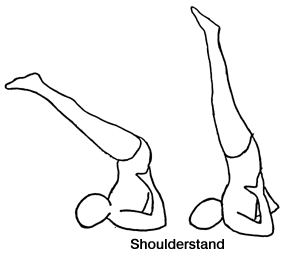
In my previous post, I wrote about the difficulties I’ve had performing shoulderstand, particularly in Iyengar classes. I think this is an incredibly powerful teaching point, demonstrating both the importance of anatomical individuality and the importance of Satya (truthfulness) in one’s own practice – in my case it is listening to one’s own body and breath.
And, as Nadine Fawell has commented earlier: Now, seriously, maybe there is a structural reason for the shoulderstand troubles – you’ve seen Paul Grilley’s video, right?
Some people can, some can’t. It’s in the bones.
So I thought I’d really start to take this pose apart…
I began by pulling the pose apart, thinking about what I find particularly difficult. I referred to Leslie Kaminoff’s Yoga Anatomy book (I really DON’T like this book – the cramped text switches off my brain) and the Muscles of Hatha Yoga. I cannot recommend the later book highly enough. It really ‘speaks’ to me.
My problems with the pose appear to be that I cannot bring my elbows in close enough to my body to enable the lift through the thoracic spine. I suspect it’s something to do with my scapula & humerus, my extremely ‘ropey’ rhomboids and a ‘deafness’ I have in my upper thoracic spine (I think I’m doomed!).
It isn’t a muscle strength problem in any of the supporting muscles. As I’ve stated previously, I have no problems with strength in the rhomboid, trapezieus, triceps or opposing groups, such as pectoralis or abdominals. I can do one armed push ups on my toes on both sides; conversely I can dead row 20kg for 5 min during a Pump class. Holding Bakasana for one minute is no problem. Likewise I can Chatauranga until the cows come home. So it’s not strength.
What it does seem to me is that I get bone-on-bone compression very quickly when my elbows are flexed behind me and then adducted inwards. To me, the neck of my humerus seems to meet the top of the scapula and stop everything else from happening. I just cannot get my elbows closer to my midline! I feel like I’m a bird flapping its wings (a duck, actually). Even when I put them out behind me in Halasana, they splay out like errant wings. When I stand up and put my elbows into shoulderstand behind my back, however, with the use of the wall I can make them come into the midline by applying force. In a way, I guess this is what the strap attempts to do … but I cannot bear the strap around my elbows! It makes me cramp and freaks me out.
In Iyengar classes, the strap is set up shoulder-width with the arms extended in front of the body, and then transferred to onto the elbows when in shoulderstand. Interestingly, I can perform shoulderstand at home or in Satyananda class without strap or blankets and be totally comfortable and non-freaked out. However, the Satyananda shoulderstand is piked.
So what should I do? Practice Salamba savangasana in a standing position using the wall on alternative sides to forcibly ‘open’ my chest (it doesn’t hurt)… or continue to do shoulderstand in a slightly piked position?


One of the best cues I’ve ever been given (and this is the first time I’ve ever written about it anywhere) is to stretch from the bones out.
So yeah, limitations might be in your bones, but then, are they really as limited as you think? The answer is generally gonna be: no, not really…
Anyway, the cue comes from my Guru, of course. Who is without a doubt, one of the most brilliant yoga teachers I’ve ever met.
Basically, don’t try to move muscle and sinew, extend from the bones. Sounds simple, but its amazing how much extra lift/length/stretch you can achieve when you really give it a go.
I’d say, stay with your piked version until its suddenly natural for it to change…
Piked. Form follows Funtion! Why would you WANT to keep working to compression? I speak as one who did all sorts of unfortunate things to her wrists, working outside their actual range of motion…
Abd you know, I don’t think our individual differences should be classed as limitations. We should reframe how we look at that…
Great post! So incredibly well-thought out!
xo
@Svasti & Nadine, thanks for confirming what I already suspected. I think the piked position is the one which is where I’m at – and have been at- for 10 years.
I feel so much more comfortable not trying to conform to someone else’s standards and yet… yet… there is a blog post coming up about yogic authenticity and legitimacy and its affect upon me in practice and mentally.
Thanks as always for reading my little blog and my mindless ramblings!